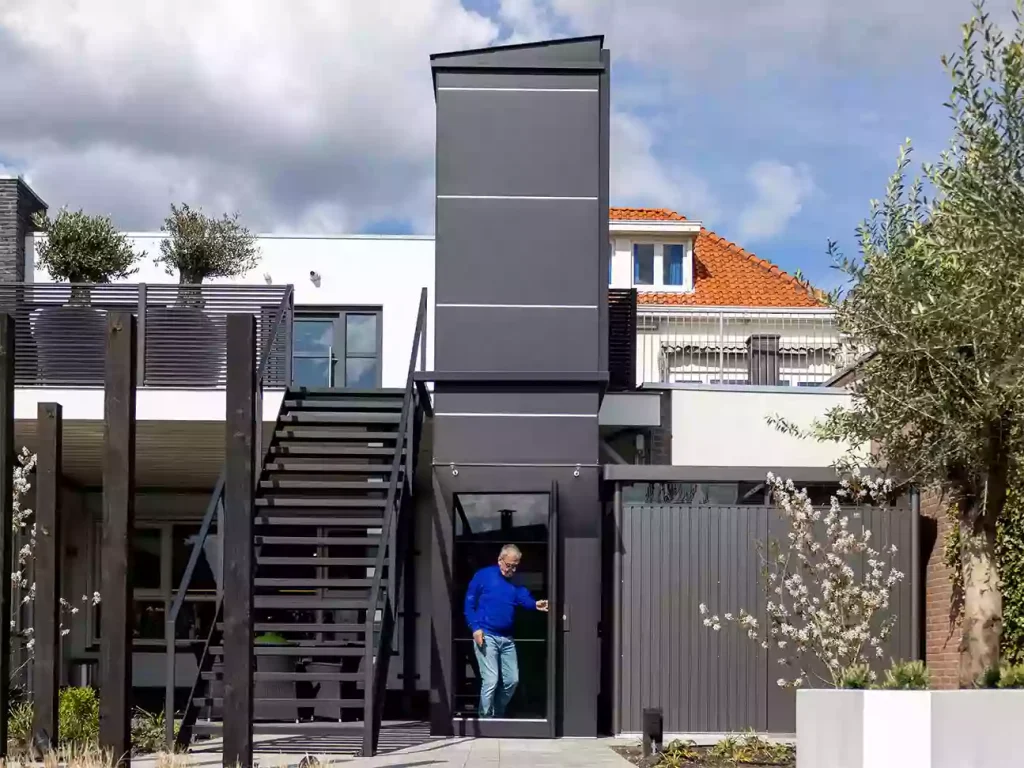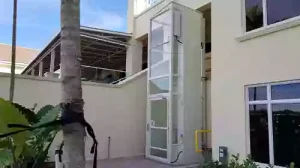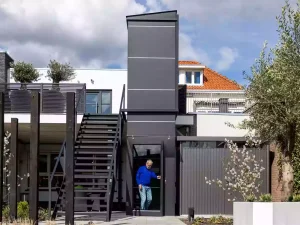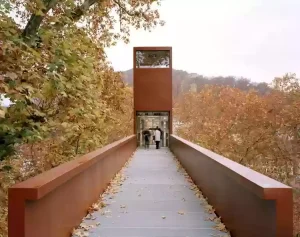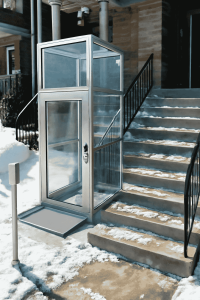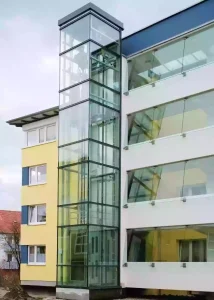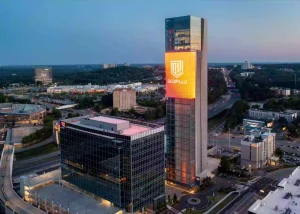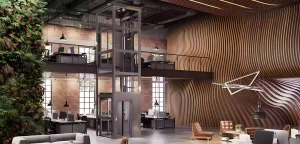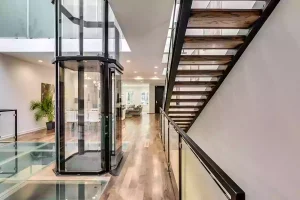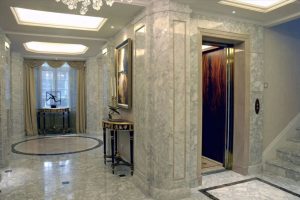Installing an outdoor residential elevator system can improve the convenience of life and increase the value of your property. However, with all the types and functions, how do you know which outdoor home elevator is best for you? This article will take you through multiple aspects to choose the outdoor residential elevator that suits you.
Evaluate your building needs
Your house layout, usage needs and available space determine which types of elevators are feasible.
Building type
First determine the structure and height of your house. Is it a two-story suburban home? A hillside villa? Or a rooftop duplex?
- Low-rise buildings (2-3 floors): hydraulic elevators or platform elevators are ideal
- Mid-rise homes or steep terrain: consider traction or machine-roomless elevators
- Old homes: structural modifications or self-supporting systems may be required
- Single-family homes: You can usually choose the elevator location freely, and machine-roomless elevators (MRL, Machine-Room-Less) are recommended to save space.
- Townhouses: Shared exterior wall structures need to be considered, and traction elevators are easier to embed into existing buildings (such as BDFUJI’s compact design that only requires a 1.2m×1.5m shaft).
Usage requirements
Daily household use: standard load of 350-450 pounds (about 2-3 people), hydraulic or traction are both available.
Wheelchair/medical equipment transportation: requires a load of more than 500 pounds, and traction elevators are recommended (such as BDFUJI T-500 model).
High frequency use (>50 times/day): traction type is preferred, and its motor life is 40% longer than hydraulic type (data source: Elevator World Annual Report).
Available space
Outdoor elevators usually require the following space:
- Hoistway or guide rail structure
- Dooring area for each floor
- Power supply and control channel
Some models (such as pneumatic or platform elevators) require only a small amount of construction, while hydraulic systems may require a foundation pit.
Understand the types of outdoor residential elevators
Different elevator types are suitable for different structural, cost and functional requirements.
Hydraulic outdoor residential elevators
Use a fluid-driven piston to lift the car.
- Advantages: smooth operation, low initial cost, suitable for 2-4 storey residential buildings.
- Disadvantages: pit required, high maintenance cost (need to check hydraulic oil).
Best for single-story houses with ground-level entrances.
Traction residential elevators
Use counterweights and steel cables driven by electric motors.
- Advantages: energy-saving, suitable for longer vertical travel, fast speed.
- Disadvantages: higher price, need for dedicated hoistway.
Ideal for multi-story houses or sloped land.
No machine room (MRL) Residential Elevator
A traction elevator without a separate machine room.
- Pros: Space-saving, stylish appearance
- Cons: Slightly more maintenance cost than hydraulic elevators
Ideal for modern designs or places with limited space.
🔗 Click here to learn more about types of outdoor residential elevators
Consider local weather
Your climate conditions directly affect the performance and life of your outdoor residential elevator.
- Cold climates: Hydraulic fluid must meet low temperature standards. Heated control panels and sealed motors help prevent freezing.
- Coastal or humid areas: Corrosion-resistant materials such as stainless steel or marine-grade aluminum are required.
Rain-prone areas: Drainage systems and canopy covers are essential.
✅ BDFUJI’s outdoor elevators are equipped with IP waterproof components, nitrided gearboxes, and optional heated shafts for winter.
Design and aesthetic considerations
Your elevator should enhance the appearance of your home, not detract from its beauty.
Consider:
- Glass or stainless steel finishes
- Transparent panoramic shafts
- Exterior color schemes
Consider safety and security features
Outdoor elevators must not only withstand the harsh weather, but also be able to cope with the actual risks of use.
Focus on:
- Emergency stop button and battery backup
- Non-slip flooring and safety rails
- Lockable control panel or remote access
- Some systems even offer smart monitoring apps for tracking usage or receiving service alerts.
Evaluate energy efficiency
Energy-efficient elevators can reduce the long-term costs and environmental impact of elevator use in your home.
Traction systems are generally the most energy-efficient, especially when equipped with regenerative braking.
Hydraulic elevators use more power, but this can be offset by solar or battery power.
Pneumatic elevators use less power, but may have limited capacity.
BDFUJI traction systems include an optional energy feedback module that feeds power back to the grid during the elevator’s descent, saving energy consumption.
Prioritize reliability and maintenance
Regular maintenance keeps your elevator safer and more effective over the long term.
Maintenance frequency (hydraulic systems: every 6-12 months, traction systems: annually)
Durability of components in extreme temperatures
Warranty coverage and availability of local technicians
Plan around your budget
A sound budget can help you avoid unnecessary costs.
| Elevator Type | Typical Range (USD) |
|---|---|
| Hydraulic | $35,000 – $55,000 |
| Traction | $45,000 – $70,000 |
| Machine Roomless | $50,000 – $75,000 |
| Platform Lift | $15,000 – $30,000 |
Factors that influence the cost of an outdoor residential elevator include:
- Site preparation and permits
- Installation labor
- Maintenance schedule
- Optional features, such as glass enclosures or voice control
🔗 Click here to view: A comprehensive guide to the average cost of outdoor elevators and factors affecting them
Choosing the right manufacturer
A reputable brand means greater safety, support, and performance.
Look for an elevator company with the following qualities:
- CE, ISO, or EAC certified
- Experience with outdoor installations
- Customizable products with clear specifications and support
Why choose BDFUJI?
BDFUJI is one of China’s leading outdoor residential elevator manufacturers, known for:
- Customized hoistway solutions
- IP-certified outdoor protection
- Fast delivery and global export experience
- Excellent after-sales support
Choosing the right outdoor elevator for home requires more than just comparing prices; it also requires balancing construction, style, safety, and long-term value.
Whether you prefer the economical benefits of hydraulics or the smart, durable, and safe BDFUJI traction elevators, remember: the best fit is always the best balance of performance, cost, and aesthetics.


